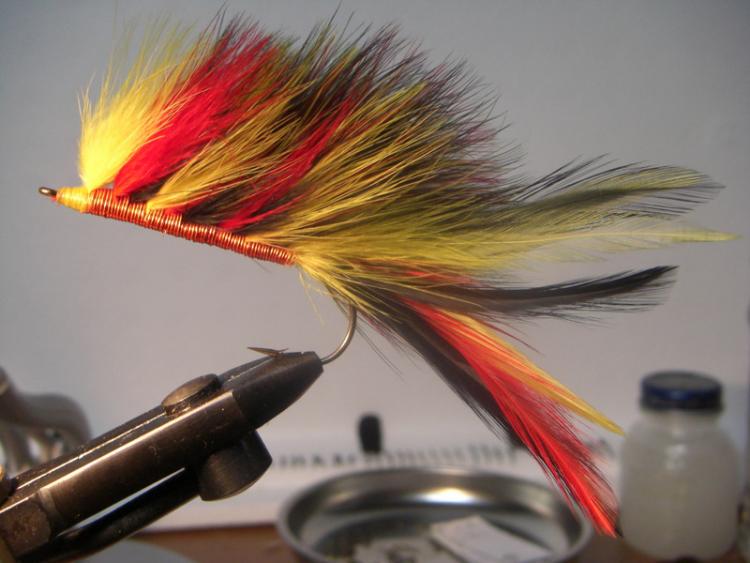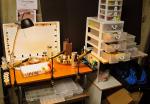-
Content Count
217 -
Joined
-
Last visited
Posts posted by navigator37
-
-
-
My setup:
-The table is a small drafting table with side attachments for holding
scissors, bobbin holders, etc. It also has a roll out bottom drawer for holding
boxes of different hook sizes.
-The threads sit on a small rotating food tray for easy access to thread types.
-The black thing glued to the center of the thread tray is an automotive sanding sponge.
When the needles you use get hardened varnish on them, you punch them into the
sanding sponge and it cleans them right off. ( you can also stick your flies on it)
-I keep my bigger materials in some Tupperware drawers to the right.
-I use a solid foam lid from a styrofoam cooler to stick the bulk of my flies on.
-The silver dish is an automotive magnetic dish. Any odd hooks lying around hold fast
inside the dish so they don't end up everywhere.
-Yeah, three inexpensive but good vises. Some of the flies I tie are varnished all over
and I don't want to touch them and risk messing them up. This way I can let
one dry for awhile and use the next vise.
That's how I'm keeping it for now.
-
Looks great, I'll take a dozen with some cocktail sauce. :thumbup:Is that woven or a rib and what is that translucent stuff in the middle? I guess what's the recipe?
Just click on 'Crystal Scud' at the top of the page by the big picture of it
for the recipe.
-
This fly uses a lot of thread and cement.
I use 2 coats of toluene/goop, or
hard as nails.
1. Tie in tan soft hackle tail and another
amount at the eye to later become legs.
Cement.
2. Tie in Stretch magic cord, wrapping to the back.
3. Wrap forwards two thirds the way up so cord is tightly covered
and will later represent the scud's internal system.
4. Pinch cord from back and bring forward, tying at the front two thirds
of the hook. This locks the cord in place.
5. While pinching rear curve of cord, wrap backwards towards the tail,
and wrap back again on the same segments you began with.
6. Cut tapered end on cord and tie down tapered end almost to the hook eye.
7. Pull back soft hackle and tie back for legs.
Don't worry if the legs look uneven and gnarly.
Scud legs aren't pretty.
-
Glad you like them.
I'm entering a step by step for anyone interested.
-
Thanks you guys.
The fly is still evolving however.
You know how that happens when you are tying
and come up with newer ideas for it.
I'm now tying the segment thread wraps closer together
than the one pictured with a slightly different tying method.
Instead of crystal hair I used tan soft hackle.
I'll post a pic of a slightly different version.
I wonder if it will work as well.
-
-
-
I mostly fish lakes now with a fast sinking line and have caught some nice rainbows
on a size 18-20 chironomid pupae imitation.
It took me a lot longer to get the fish in but they were very releasable.
I got a 4 weight sinking for this very purpose in fishing these smaller flies.
I guess it will just take more skill to see if I can play a fish back
without straightening the hook out or parting the tippet.
A 7x or 8x tippet just passes through the eye once with no room to spare.
-
Has anyone on the board ever used these size 32 hooks to land a decent sized trout?
I thought it would be a challenge and a half to actually land a nice
 sized trout on one.
sized trout on one.They are good quality TMC hooks and seem sturdy enough for their size.
Has anyone ever landed a decent trout on these?
My hands aren't the best for tying small flies so I'm keeping them simple.
Is this a waste of time?
-
I'm in Regina, Sask.
Yeah some people don't know what they
are missing do they?
Oh well, more fish for me I guess.
-
Thanks alot.
Of course you can use a cone head option as well.
Some also insist on using red for their pike flies, so
a small red hackle after the white at the front might be ok.
Overall it still works very well as it is.
-
-
I caught a clam once.
Strangest thing I've ever seen caught?
When I was younger I saw a guy fishing next to me reel
in an old five dollar bill.
-
I recently made some of it and it's great.
I got my toluene from a local hardware store
as well as the marine version of Goop.
I used old baby food jars and added one third
toluene and two thirds goop.
After a lot of mixing it thinned out very well
though took on a very slight whitish color
though it looks clear when on the fly.
It dries in little time a forms a solid but rubbery
finish. Kind of like Dave's Flexament.
Depending on how much toluene you use of course,
the smell is not that bad.
-
Hi everyone.
I've been flyfishing for about 26 years now.
I recently came across this great site and am hoping to get
some ideas and share some patterns as well.
I've seen that most of you don't stick to traditional patterns
and I can relate.
I use to be heavy into flyfishing and tying but got so neck deep
into my job and other work. I hadn't been tying
for a long time.
Recently, I finally went out north and tied into some
big rainbows on one of my favorite old lakes.
The fever is back again and it's back for good.


















Marabou Magnum
in The Fly Tying Bench
Posted · Report reply
Thanks you guys. With a stop and go retrieve, it really
pulses in the water.